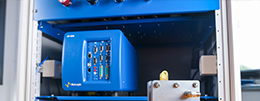Faraday cages
Faraday cages
Keep artifacts away from your cell
The presence of other electrical equipment in the lab can affect your measurement, especially when measuring high impedance systems or very low currents. In this situation, electromagnetic noise emitted by external equipment can be picked up. To prevent this from happening a Faraday cage is needed.
Description
The Faraday cage needs to be earthed by connecting the outer shell of the cage to the earth (green receptacle at the back) of your instrument. It is also important to maintain the cell in the center of the cage. For this purpose, a rod is set by default and an optional stand can be purchased.
The design of the Faraday cage is optimized for low current/high impedance measurements: the use of the inner stand minimize measurements of parasitic contributions by centering the cell inside the Faraday cage by using non-conductive materials.
Further details are given inside the “specifications” tab.
Specifications and ordering information
| Faraday cages | |
| Dimensions (H x W x D) /mm | 450 x 450 x 450 |
| Material | Stainless steel 430 |
| Cable feed-throughs /mm | For cables, left panel feed-through: - Rectangular, 140 x 40 mm. This feed-through can be minimized to limitate parasitic effects. Rear panel holes: - 2x holes, 20 mm diameter (can be use for water tubing). - 2x holes, 15 mm diameter (can be use for gas tubing). |
| Earthing connection | 4 mm green plug available on the rear panel to connect to the instrument earth chassis ground. |
| Inner parts | A rod (12 mm diameter) is provided inside the cage to fix the cell or the cell cable. Nut and clamp are not provided. A stand (PN: 094-084/2) is offered as option. It is made of two metallic plates of 200 x 200 mm separated by a plastic tube of 146 mm. This stand can be screwed to the Faraday cage. It is compatible with BioLogic coating, flat and galvanic cells. |
| Catalog n° | |
| FC-45 Faraday cage | 094-084/1 |
| Stand for FC-45 | 094-084/2 |





